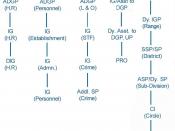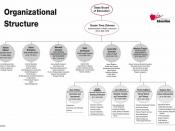Kudler Fine Foods Organizational Behavior
This paper will identify Kudler Fine Foods' culture, organizational structure, leadership, and identify factors that will drive change to improve the company's competitive advantage. Kudler Fine Foods is a gourmet food store that is focuses on providing a wide selection of products to finicky shoppers. The founder, Kathy Kudler, stays competitive by monitoring other gourmet food stores through websites, staying current on any new items that may be offered.
Organizational Culture
Kathy Kudler has assumed the predominant task of defining her organizations' culture through her own values, beliefs, and experiences. The idea for opening Kudler Fine Foods was birthed out of a need from her community's desire for gourmet foods. Kathy's personal experience has translated into defining what outsiders identify with Kudler Fine Foods.
Kathy takes on the daily tasks of making decisions for the entire chain of Kudler Fine Foods without the input of her employees and her appointed leaders.
Because her leadership style Kathy has made the entire organization dependent on her. This style may cause her frustration and angst. The organizational culture that Kathy has unknowingly created is passive defensive. The normative belief of this type of culture is dependency, which describes Kathy's role in the organization.
Passive Defensive organizations are hierarchically controlled and non-participative. Centralized decision making in such organizations leads members to only do what they are told and to clear all decisions with superiors (Cooke,1993). Kathy is using the same leadership and management style with the chain of stores that she used when she had one store. She may find it difficult to remove herself from the dominant influencer role because Kudler Fine Foods represent her.
Organizational Structure
Kudler Fine Foods organization is structured using centralized administration. According to Gomez-Mejia and Balkin (2008, p. 12), an effective way to...


